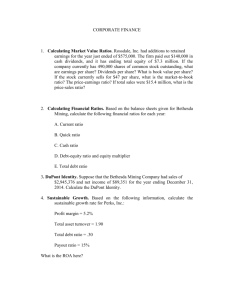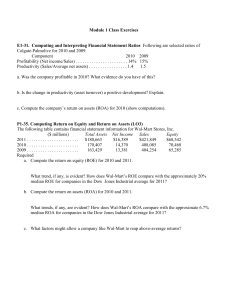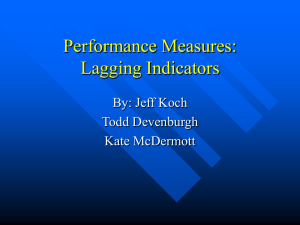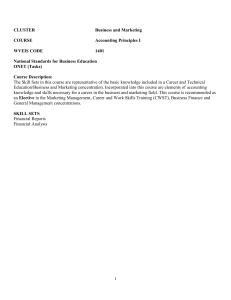File
advertisement
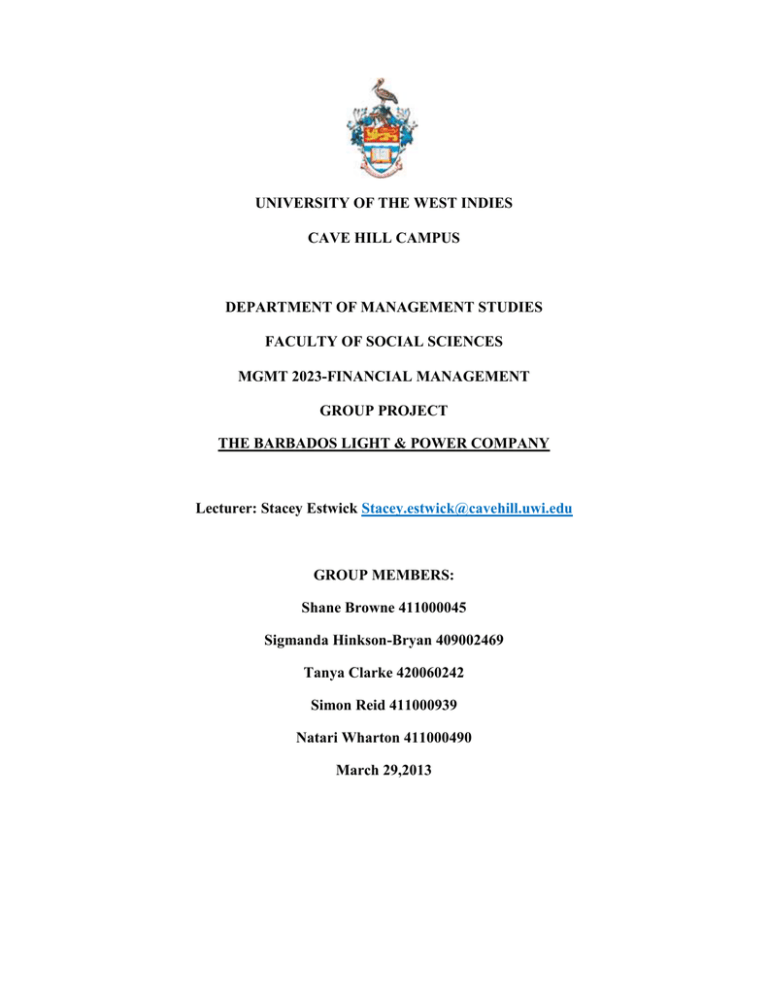
UNIVERSITY OF THE WEST INDIES CAVE HILL CAMPUS DEPARTMENT OF MANAGEMENT STUDIES FACULTY OF SOCIAL SCIENCES MGMT 2023-FINANCIAL MANAGEMENT GROUP PROJECT THE BARBADOS LIGHT & POWER COMPANY Lecturer: Stacey Estwick Stacey.estwick@cavehill.uwi.edu GROUP MEMBERS: Shane Browne 411000045 Sigmanda Hinkson-Bryan 409002469 Tanya Clarke 420060242 Simon Reid 411000939 Natari Wharton 411000490 March 29,2013 Table of Contents Introduction…………………………………………………………………. Summary of company………………………………………………………….. Financial statement analysis of financial ratios……………………………………. Analysis of company’s liquidity…………………………………………………. Analysis of company’s profitability……………………………………………. Conclusion………………………………………………………………………….. Recommendation to potential investors……………….………………………… Appendix………………………………………………………………………… Bibliography…………………………………………………………………….. Introduction In this project we will seek to analyze Barbados Light & Power’s financial statements using various categories of ratios. These include liquidity, financial leverage, asset utilization, market value and profitability ratios. In addition we will also examine the strengths and weaknesses of BL&P as well as commenting on the overall health of the company giving recommendation to a prospective individual investor who is seeking capital gains. Summarization Since 1911, The Barbados Light & Power has been the sole provider of electricity in our island. One can appreciate that fact that we are living in an ever evolving world and many businesses, including BL&P have been forced to evaluate their product. With that being said this company in currently preparing for their next phase of generation replacement and expansion. They have embarked on an Integrated Resource Planning process to help determine the optimum plan to meet customers’ needs. IRP is estimated to span a period of 20 to 30 years as it retires a potion of its oil fueled capacity and replaces it with alternative renewable energy. This process will include acquiring land for the development of wind farms access to a secure supply of biomass and landfill gas extension of BL&P franchise which currently expires in 2028 Fair Trading Commission approval of the IRP Compliance of the legislative requirements The company has currently taken into consideration, the CO2 that will be produced, water and land use, the fuel diversity and the net present value. As a publicly traded company, BL&P have included their shareholders in this process, soliciting their comments, queries and questions before they proceed with this venture. Shareholders have been given until Feb 2013 to submit their contribution. This will be followed by a submission of the IRP report to the FTC for approval. In the midst of their future plans, the BL&P have recognized that an immediate cause of action is necessary. This need birthed the Fuel Clause Adjustment Programmed. This programmed adjusts the rate the customer pays for each kilowatt hour of electricity as the cost of fuel fluctuates. This does not add to the company’s profit as the funds go to the oil suppliers. The FTC is responsible for setting and monitoring the rates the BL&P charge its customers. Barbados Light & Power’s electricity is generated by diesel, steam and gas turbines. Also, the supply is clean and reliable and instances of power outages are generally rare. The company is presently exploring alternative energy sources in its quest to supply a reduced cost of electricity to all customers. The plant functions on the lowest cost residual fuel accessible and is realizing considerable efficiency and as a result consumers receive all the benefits. However, in 2009, the Company had applied to the Fair Trading Commission for an adjustment of electricity rates. Since 1983, this had been the first rate hearing sought by the company. Due to the company’s financial situation, expansion needs, as well as the importance of electricity to national development and the anticipation of new business and residential developments on the island there were granted the increase by the regulator. Despite many appeals by interveners, who had spoken out against the rate increase during the hearing, the new rates had gone into effect from March 2010. Meanwhile, the relationship with Leukemia National Corporation, which was forged in the early 1980s ended in 2010, when Emery, a Canadian-based company acquired 38% interest in Light & Power Holdings. Thereafter, Emery had made an offer to shareholders to purchase all issued and outstanding common shares in Light & Power Holdings. The offer had been accepted by most of the shareholders and by early 2011, Emery had owned 79.7% of Light & Power Holdings shares, thereby making it the largest single shareholder. Furthermore, the remaining shares are held by the National Insurance Board and approximately 1,700 other shareholders. Simultaneously, as Barbados Light & Power continues to press forward, one of its biggest challenges will be finding alternative energy sources which are clean, efficient and less costly. Moreover, in this regard it has kept itself abreast of the latest developments in alternative energy, and has taken exploratory steps towards this goal. Liquidity Ratio Analysis Liquidity ratios are used to determine a company's ability to pay off its short-term obligations by turning its short-term assets into cash. In the analysis of the financial statements of BL&P, four common liquidity ratios were used to determine the liquidity of the company. The current ratio shows how well the company's working capital is being managed. A current ratio of one (1) or more indicates that the company can pay off its short-term debts. This ratio compares the current liabilities to current assets to determine if the company can pay off its debt. In 2008, BL&P recorded a 2.82 ratio and in the 2009 a ratio of 2.37 was recorded. Also in 2010 and 2011, ratios of 2.76 and 2.74 were recorded respectively. Overall, an average of 2.67 was reported for the years 2008 through 2011. This indicated that the company is financially liquid and is able to pay off its short-term debts using its short-term assets. The quick ratio is used to determine whether or not a company can pay off its short-term debts by turning its short-terms assets excepting inventory into cash. In 2008, BL&P reported a 2.15 and in 2009 there was a significant decrease to 1.90. This decrease although falling below 2.0 is still a relatively good ratio. However, this decrease could have been detrimental to investors. In 2010, there was an increase to 2.36 and in 2011 a slight decrease to 2.31. It is secure to say that BL&P is financially liquid and investing in this company would have little risk. The cash ratio is an indicator of a company's liquidity by measuring the amount of cash, cash equivalents or invested funds there are in current assets to cover current liabilities. This measure ignores inventory and receivables as there is no assurance that these two accounts can be converted into cash in a timely matter to meet current liabilities. In the four year period of 2008-2011, BL&P reported cash ratios of 1.11, 1.31, 1.70 and 1.51 respectively. A cash ratio above one (1) signifies that the company is able to meet its short-term obligations. BL&P cash to current liabilities has never fallen below one (1) and has fluctuated during the four year period. The cash return on assets ratio is the cash flow from operations. A high cash return on assets ratio can indicate that a higher return is to be expected. This is because the higher the ratio the more cash the company has available for reintegration into the company. In 2008, the cash ROA was reported at 0.06 and increased significantly to 0.11 in 2009. In 2010 and 2011 the ratios were 0.16 and 0.15 respectively. It is seen here that after 2008 the cash ROA never went below 0.10 and which was slightly fluctuated. Profitability Ratio Analysis Profitability ratios measure a company’s ability to generate earnings relative to sales, assets and equity. In one form or another, they are intended to measure how efficiently a firm uses its assets and manages its operations. The profitability ratios used in the analysis of BL&P were the profit margin, return on assets (ROA) and return on equity (ROE) ratios. Profit Margin Ratio The profit margin ratio is calculated by: Net Income Operating Revenue This ratio measures how much out of every dollar of sales a company keeps in earnings. It is very useful when comparing companies in similar industries. A higher profit margin indicates a more profitable company that has better control over its costs. Profit margin is displayed as a percentage i.e. a 15% profit margin means the company has a net income of $0.15 for each dollar of sales. For BL&P the profit margin was 6.70% in the year 2008. This means that the company had a net income of $0.0670 of every dollar of sales. This value fell to 6.60% in 2009 then rose to 8.98% in 2010. This value declined by 3.16% to be 5.82% in 2011. BL&P kept the highest percentage of sales in earnings in 2010 as they kept $0.0898 of every dollar and had the lowest percentage in 2011 as they kept $0.0582 of every dollar of sales in earnings. Return On Assets Return on assets is calculated as: Net Income Total assets Return on assets (ROA) is a measure of profit per dollar of assets. It gives an idea as to how efficient management is at using its assets to generate earnings. ROA tells you what earnings were generated from invested capital (assets). ROA for publicly owned companies can vary significantly and will be highly dependent on the industry. This is why when using ROA as a comparative measure, it is best to compare it with a company's previous ROA numbers or the ROA of a similar company. BL&P had a ROA of 3.38% in 2008, 3.11% in 2009, 4.94% in 2010 and 5.82% in 2011. This shows that the company became more profitable as the number of cents earned on each dollar increased over the 4 year period that the company was being analyzed. In 2008, the amount of profit per dollar of assets was $0.038 and rose steadily to $0.582 in 2011. Return on Equity (ROE) The formula for calculating return on equity is Net Income Total equity ROE is the amount of net income returned as a percentage of shareholders equity. Return on equity reveals how much profit a company earned in comparison to the total amount of shareholder equity. Since benefiting shareholders is the main goal of the organization, ROE can be seen as the true measure of performance. ROE in 2008 was 5.82% then increased to 4.42% in 2009, increased to 6.90% in 2010 then decreased again in 2011 to 5.13%. This shows that the value of net income returned as a percentage of shareholders equity fluctuated over the years with it being the lowest in 2009 with $0.0442 of every dollar of net income returned from shareholder equity and a highest value of $0.069 in 2011. Conclusion It is evident that The Barbados Light & Company has experienced a challenging time during the years 2008-2011.For example from 2008-2011, Return on Assets (ROA) was 5.28%, 4.42%,6.90% and 5.13% respectively. The wholly owned subsidiary’s liquidity ratios were constant over the trend analysis period. Those results meant; for example the current ratio showed a percentage of 2.74% which indicated that the company has twice as many current assets available as current liabilities. Moreover, the company’s market to book ratio which is used for valuation purposes highlighted a decreased during the four year period and all the ratios were less than <1.0; a less than desirable value for a company of that size and even worse for investors. This reflects an indication of an undervalued firm. In addition, these failures with respect to BL&P’s profit margin, return on assets or the return on equity is reasonable explanation for investment of any kind. It is clear that Barbados Light & Power was not in a good financial standing during the period 2008-2011 because of the many negative decreases that they encountered. This makes them very unprofitable for anyone to invest in their company at present. Their financial status started to improve overtime which is reflected during the year 2010 profit margin. It is observable that 2010 was the rewarding year for BL&P although 2011 eclipsed any improvements seen. Recommendation to potential investors Profits are important to companies and investors. Consistently high profits usually mean efficient management and good investment opportunities, bringing in more capital and growth. Profit margins are financial ratios that tell investors how profitable companies are despite different types of costs; profits however can be misleading, so investors need margins to make informed investments. From analyzing the profit margin ratios calculated from 2008-2011,an investor may have a reasonable degree of uncertainty of investing in BL&P since the company substantial profits were fluctuating. However, the decision would be unlikely as a result of the sharp, significant decrease of 5.82% in the year 2011 for the profit margin. Simultaneously, they can focus on different market strategies and increase market penetration. Not only would this result in an additional profit return on equity, return on assets but also improve liquidity and the current and quick ratios. Appendix Bibliography http://www.blpc.com.bb/co_his.cfm

